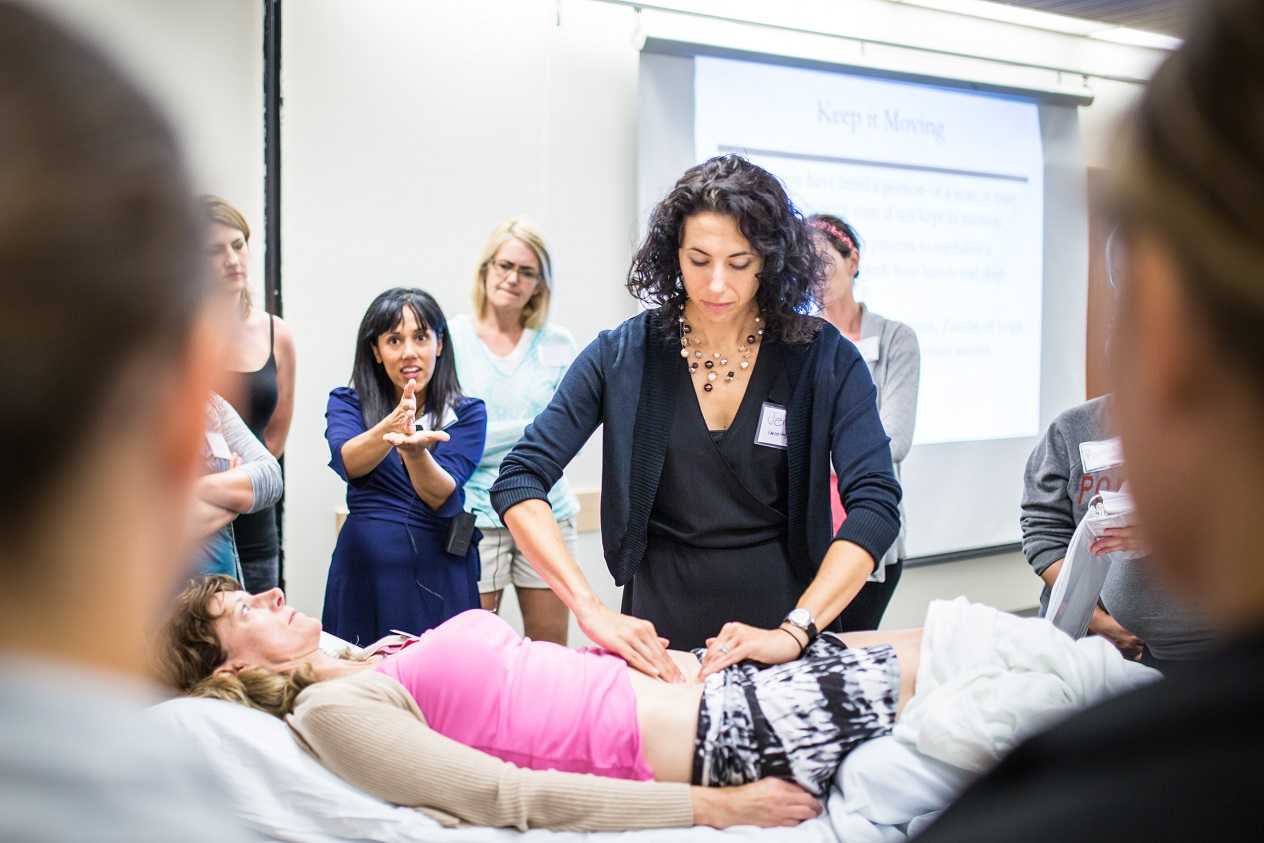I have seen several articles talking about the “Grey Effect.” The idea is that the incredibly popular book series beginning with “Fifty Shades of Grey” has created a frenzy of female sexual interest. (When I say “incredibly popular” the series has allegedly outsold the paperback Harry Potter series…) I won't go into detail about the book, or about the various critiques and controversies, let's save that for the people who are well-poised to do so. In a nutshell, the book series contains “explicitly erotic scenes.” Reports suggest that the book series craze is sending women in droves to the sex toy shops and is giving women permission to explore their sexuality. What does that have to do with pelvic rehabilitation?
The book may be a topic of discussion with our patients and this in itself may encourage us to explore our own comfort zones related to sexual health. How do you respond when a woman says that she has pelvic pain, is using a sex toy to stretch the vaginal opening, but her husband's penis is much bigger than the toy and she still has pain? How do you give advice about masturbation- or do you? What is the correct response to "my partner thinks I should be able to have an orgasm with penetration?" The replies to any of these questions depend on several factors, such as your level of knowledge about sexual health including anatomy and physiology, your own belief systems, the standards and culture at your place of work, as well as your understanding of sexual practices that are different from your own. What are the ethical issues that surface when faced with the above questions? If you are outside of your comfort zone and do not want to talk about sexual function, is it ok to say so, or are you denying your patient access to available information? How much do you share, knowing that these conversations are intimate and potentially confusing if your patient has poor boundaries? What if a patient asks you some questions and you are feeling unclear about the patient's motivations? These are really good topics for discussion, and outside of giving comprehensive answers, I would like to point out some ideas and resources that may be helpful to you. The Herman & Wallace Pelvic Rehabilitation Institute offers several courses that provide education about sexual health and function or dysfunction. All courses in the series discuss sexual function to some extent, and the Level 3 course has quite a bit of detail about sexual health. The Male course discusses rehabilitation of male sexual function, and there is a newer class instructed by Heather Howard, PhD, all about sexual interviewing and counseling.
It can be a challenge to navigate this territory as this type of “real-world” education rarely happens in school. First, we have to respect ourselves enough to take care of ourselves. This means that when you are not feeling very comfortable with the content of the conversation, say so. A statement such as “I'm not really comfortable with our conversation, let me think about your questions and come back to that next visit if that works for you.” This allows you to take the time to consult with a mentor, a supervisor, or a textbook if needed, or to process how you feel about the question so that you can give a more objective answer. If the patient is being inappropriate, such as asking for your phone number or saying anything suggestive, bring it up. “That is an inappropriate comment, and in order for you to continue to attend rehabilitation here, you must respect that.” If the inappropriate behavior continues, fire the patient, document it, contact the referring provider, and move on. If you are not really sure what sexual technique or act the patient is referring to, a phrase that can be helpful is “tell me more about that.” It is possible to discuss body mechanics in a respectful, professional manner even when discussing sexual health. It's not typically the way we are acculturated, so it takes practice and thoughtfulness.
When patients are interested in accessing websites for the purchase of devices to stretch, stimulate, or vibrate the pelvic muscles, the vendors listed on the hermanwallace.com website have ordering information for some commonly chosen devices. Other sites that are helpful for the patient are www.babeland.com or www.goodvibes.com. The American Association of Sexuality Educators Counselors and Therapists or AASECT website is also one that might be helpful for you as a provider or for your patient as a consumer. If you are looking for a certified sex therapist, that site also lists them by region. Most experienced therapists will tell you that as long as we stay open and listen well, it is our patients who will teach us as much as we can learn in any course or textbook. Optimizing our own comfort levels with sexuality can bring us closer to having meaningful dialog with our patients who trust us enough to inquire about such sensitive topics.
A colleague recently sent an inquiry through the Institute asking if there is new research supporting pelvic floor muscle training after radical prostatectomy. As a matter of fact, I chose not to report on some recent research that I read, because it does not support conservative care for urinary incontinence (UI). The Cochrane review for postprostatectomy UI was updated this year, and the results of the review indicate that we need more and better research. (If you are unfamiliar with the Cochrane library, one of its 6 databases contains systematic reviews of the literature that are updated periodically.) Although within the abstract of the reviewthe report states that there is a lack of consistency in the interventions, the populations, and in the outcome measures, the value of conservative approaches is deemed "uncertain." The authors do conclude that benefit from one-to-one pelvic floor muscle training is "unlikely" following transurethral resection of the prostate, or TURP.
The critiques of the research listed in the review include the above mentioned lack of consistency in outcomes and interventions. Most of the studies also did not include a report of pre-surgical outcome status, of adverse effects, and lifestyle changes as an intervention was never identified in any of the research. This leads us to this question: why are we treating men for UI or erectile dysfunction (ED) if this systematic review brings into question the efficacy of what we do? Certainly patients are improving as a result of pelvic rehabilitation, or I doubt that the medical providers would continue to refer patients to the offices who provide rehabilitation to these patients. What we do not know about each of the studies is how much of the male anatomy was affected by the procedure for the prostate. The patient's pre-surgical status and the skill level of the surgeon are both known factors for outcomes following prostatectomy, yet how are those quantified in the literature?
Most importantly, how can we be a part of the solution when it comes to creating research to support the services that we provide. It may be helpful as therapists to be certain that we are maximizing the level of knowledge about the surgeries, the anatomy involved, and about the available treatments. This can mean attending coursework that is specific to or includes discussion of male pelvic floor issues. (Check out the Pelvic Floor Series level 2A course or the Male Pelvic Floor Courses offered by the Institute, especially if more male patients are finding their way to your door.) Speak with referring physicians about surgical techniques, observe some surgeries, or attend a urology conference (maybe there's one near your hometown, or you want to attend with your local referring urology group.) Always document using outcomes studies when you can. Write a case study. You can even purchase a text book that teaches you step-by-step how to write a case study. I know that you don't have time...so, create a weekly lunch meeting at work with a colleague where you each work on and critique each other's project. Getting involved with local university programs can also allow you to be part of the research solution.
In summary, we need more and better research that documents how we are helping our patients. In relation to male patients following prostate procedures, who is screening these men to decide if they have tight, painful pelvic floor muscles versus weak muscles with lack of awareness of their use? We are the best chance the patient has in helping with the rehabilitation process. It is also imperative that we are testing muscle function in men to help categorize the patient as someone who might improve with an exercise-based approach or as someone who might need a trial of pelvic floor muscle electrical stimulation. If you tend to complete internal muscle testing with women, yet feel uncomfortable with this approach in men, I encourage you to move forward in your practice of this critical skill. We need to catch the patients early on who seem to have no muscle function and no awareness, and then refer that patient back to the surgeon within a reasonable time frame if there is a lack of progress. A few of the men I worked with who went on to have a male sling had very positive outcomes, and they also were very grateful that they had a pelvic rehabilitation provider to give guidance and feedback along the way. Patients who are more aware of their pelvic muscles, how to use them (and not use them!), and who know how to take care of their pelvic muscles throughout their lifespan are better poised to handle the post-surgical pathway if they should require further intervention.
What pelvic symptoms can vitamin D deficiency be causing in our pelvic rehab patients?
Vitamin D deficiency has been researched heavily in relationship to topics such as autism, fertility, multiple sclerosis, orthopedic health, muscular pain, osteoporosis, as well as pelvic floor health. Deficient levels of the vitamin have been reported as reaching "pandemic" levels, with risk factors including old age, dark skin, obesity, Chrohn's disease, occupations that require indoor activity, or living in cultures that require covering of face and body. The use of sunscreen to prevent UV exposure has also been linked to poor vitamin D levels as the sun is one way that we receive vitamin D.
Following is a brief list of research that has linked vitamin D to pelvic health issues:
- A study published this year reported that symptoms of dysmenorrhea were significantly reduced with administration of a single oral dose of vitamin D.
- Research regarding prostate cancer prevention is thought to be assisted by Vitamin D, with animal model research demonstrating protective effects, yet significant questions remain about the true effects in human populations.
- Vitamin D deficiency is associated with urinary incontinence in men in this national study, and also with other lower urinary tract symptoms.
- Higher vitamin D levels are reported in this research to be associated with a lower rate of pelvic floor disorders in women including urinary incontinence.
It is also important to be aware of comorbid conditions and current medications as both can lead to vitamin deficiency.According to the National Institute of Health's (NIH) Quick Fact sheet, medications that may interfere with vitamin D include corticosteroids, weight-loss drugs such as Alli, the cholesteral lowering drug cholestyramine, and some anti-epilepsy medications. The NIH has a more detailed fact sheet for health professionals that can be accessed here.While it may or may not be in your scope of practice to prescribe nutritional supplements, it is appropriate to share research reports and to inquire if the patient has had nutrient levels, such as vitamin D, checked by her physician. Further research may clarify the effects of low vitamin D levels in the body which are critical for healthy function.
The Agency for Healthcare Research and Quality (AHRQ) Julyfeature story is one of hope for improving care for women who suffer from issues of urinary incontinence or pelvic pain. The AHRQ publishes reviews of literature on various topics and then prepares documents for both the clinician and the consumer summarizing the findings of the research. Reviews pertaining to female urinary incontinence and female pelvic pain were updated this year, and the evidence, according the the summaries, is encouraging of pelvic rehabilitation therapies as opposed to medications and surgical approaches.
The AHRQ is the research arm of the US Department of Health and Human Services, looking at issues within health care quality, costs, outcomes, and patient safety. In preparing the evidence summary for urinary incontinence, 889 research articles were reviewed. The report states that 25% of young women, 44-57% of middle-aged and postmenopausal women, and 75% of older women in nursing homes report urinary incontinence (UI). Age, pregnancy, childbirth, menopause, hysterectomy, and obesity are all recognized as risk factors for UI, and when we consider how many women within our patient populations (or community populations) present with such risk factors, we can begin to understand the scope of the problem. The report notes that pelvic floor muscle training (PFMT) alone is as effective for stress and mixed UI as when adding biofeedback, bladder training, or electrical stimulation. For urgency UI, bladder training alone is as effective as bladder training with PMFT. Also according to the report, 19.5 billion dollars annually are spent for treatment of UI. To access the clinician summary regarding the non-surgical treatments for urinary incontinence, click here, for the patient summary, click here. The patient, or "consumer" file is also available in an audio version on the AHRQ website.
In the March 2012 research activity update, the AHRQ issued a statement that evidence is lacking to support surgery for pelvic pain. Based on the review of pelvic pain treatment options, there is a recommendation for further studies not only related to surgery, but also for conservative options for treating pelvic pain. In the comparative effectiveness review summary for patients, that can be accessed here, it is recognized that irritable bowel syndrome, endometriosis, painful bladder, tense pelvic floor muscles, or scar tissue can all create pelvic pain. It is also noted that a provider may refer a patient for physical therapy. In the clinician summary of the effectiveness review it is stated that there is not enough evidence to conclude that pelvic muscle therapy is effective for treating pelvic pain. This leads us to a common conclusion in health care: we need more clinical research that helps us answer questions about effective approaches for treating pelvic pain.
If you are interested in creating an opportunity to participate in clinical research, contact a local university physical therapy program to inquire about options. If you feel that you lacked training in research methods or concepts of evidence-based medicine, try taking a local or on-line course in one of the above topics. You do not need to be enrolled in any particular program to take a course, and you may even be able to audit a class if you contact a nearby educational facility.
The value of being aware of these documents created by the AHRQ is that we are often in a role of educating patients about treatment options. It is important that we represent the accuracy of the research as evaluated by government committees, and stay abreast of updates and additions to the body of knowledge. It is also helpful to direct patients to these websites when we know our patients are able to further empower their own lives by having more information.
On at least a weekly basis, most pelvic rehabilitation providers hear "I didn't know there was therapy for my condition." We also have to field questions about why the medical provider did not refer to rehabilitation before recommending surgery or drugs. One of the best ways for us to improve the lack of awareness in our communities is to go out and speak to them. While we have opportunities throughout our work and personal time to share information about what we do in practice, we can maximize the sharing of information by preparing a more formal option than simply giving our "elevator speech" from time to time.
A community presentation takes a little preparation and possibly a few tools. Fortunately there are many resources available for you to utilize when giving a talk to the public. Here is a look at what you might consider:
- The audience- to whom are you going to present information? Find out exactly who, how many, and what the goals of the audience is ahead of time. Showing up to give a talk about urinary incontinence when the group thinks you are speaking about arthritis could be awkward. It is also helpful to make sure there is enough space for those in attendance so you are not distracted by trying to add more chairs, move tables, etc.
- The topic- sometimes it is helpful to keep the topic broad, for example, "what does a pelvic rehabilitation provider do?" may be a generally interesting presentation. However, if you are speaking to a bladder pain/interstitial cystitis support group, you may want to me more specific in addressing bladder dysfunction and pain.
- The length- community members (and potential patients) want to ask questions. Inquire how much time you will have to speak, and then if there is time allowed for questions and answers. If there is not time allocated for answering questions, leave 10-15 minutes at the end of your presentation (and possibly plan to stick around a few minutes more if needed.)
- The presentation- unless you are speaking to medical residents or another professional group, skip the powerpoint. If you can bring a pelvic model, bring a prop like you may have seen an instructor use during a demonstration, or bring a chart or other visual aid, this may allow to you speak more naturally, tell a few stories. It also avoids the inconvenience of dealing with IT issues at the last minute.
- The giveaways- always bring with you some business cards and some brochures if you have them. Attendees will want to walk away with something tangible so they can contact you or tell a friend or loved one about your services. There are also sites that allow you to download and print handouts for patients. National sites such as the NIDDK have patient information about urinary incontinence in men or women (click on either word to access the document) and you can see that the handout is not copyrighted. You will also see that the handout is available in both Spanish and English versions. Other giveaways might include a water bottle, a stress-ball to squeeze, or a pen with your clinic name on it.
- Where to present- the options are endless, especially if you are willing to be creative and think outside of the doctor's office. Check with your local health clubs, they often allow presenters to come in and share information. Assisted care facilities are used to organizing activities for residents, and local hospitals may allow you to speak. Look on your newspaper community activity page or hospital website and see what support groups are meeting- perhaps a prostate cancer group, bladder pain group, fibromyalgia group, pregnancy class. Contact key educators at a local university, is there a classroom where you can provide a short lecture?
An article appearing in The Journal of Sexual Medicine asks the following question: do bicycle seats damage the female pelvic floor? The authors studied the affects of bicycle set up on genital sensation and saddle pressures among female cyclists. Subjects included were premenopausal, non-pregnant women who rode at least 10 miles/week, and the women used their own bicycles and saddles for the study. Genital sensation was determined with use of a biosthesiometer, a research device that measures thresholds of vibration in the body. A pressure map was used to record perineal and total saddle pressures. When the bike handlebars were positioned lower than the saddle, increased perineal pressure and decreased anterior vaginal and left labial genital sensation was noted.
Prior research published in the same journal reported that female cyclists can suffer from genital pain, numbness, and swelling, and that debate exists regarding best bike seat/saddle design. 48 cyclists were included in this research, and more than half of them used traditional saddles versus "cut-out" or narrow saddles with portions of the seat removed to avoid pressures on the perineum. Although there was an association of decreased lower mean perineal pressure with use of traditional saddles, these differences were not statistically significant. Overall, cut-out and narrower bike seats were found to have increased saddle pressures measured by a specially designed pressure sensor.
When educating our patients about pelvic health and biking, the most important factor to consider is overall fit. Many therapists are trained in the evaluation of bike fit, if you are not, consider adding those skills to your tool box, or get in touch with an expert for referrals. By contacting a local bike shop, you can get names of bike experts or therapists who specialize in fitting. To learn more about bike seats and posts, click hereand you can find an entire website devoted to concepts of bike fit, including classes that you can attend to become certified in bike fitting.
Authors of each study mentioned state that more research is needed to determine if bike saddle pressures affect pudendal nerve health, sexual function, and pain. To determine if bike fit is a part of your patient's issues, ask her detailed questions about how much time is spent on the bike, what kind of bike (mountain bike versus road bike), what position she is in most of the time (in the "drops" or lowered handle position versus upright), what kind of terrain she rides (bumps that can jar the pelvis versus smooth roads), and what kind of symptoms that she has on and off the bike. Female runners were found in one study to have improved perineal vibratory sensation thresholds when compared to competitive cyclists, indicating that biking can impact genital sensation and potentially create other pelvic dysfunctions.

Your Pace Yoga is a home yoga program that was designed by Dustienne Miller MSPT, WCS, CYT,who is a board certified women’s clinical health specialist in physical therapy and Kripalu Yoga teacher.
This program is intended for men and women who are healing chronic pelvic pain. The DVD video weaves together breath work, meditation, body awareness, and gentle yoga postures. This stress relieving program can be practiced in as little as twenty minutes, making it possible for the patient to fit into daily life.
The DVD can be purchased HERE
Dustienne also has a blog, Your Pace Yoga, which provides resources and information about yoga, pelvic pain and wellness.
Keep up the great work, Dustienne! The Institute is proud to endorse these excellent clinical and patient resources!
Recent research in The Journal of Pediatric and Adolescent Gynecology points to the alarming number of young women who present with pelvic pain who in fact also have endometriosis. Dr. Opoku-Anane and Dr. Laufer report that prevalence rates of endometriosis in an adolescent gynecology population have likely been underestimated (reported range of 25-47%) and that with advanced surgical methods the rates have been estimated to be as high as 73% in those who have pelvic pain. In their retrospective study, 117 subjects ages 12-21 completed laparoscopic examination for endometriosis. These subjects did not previously respond to non-steroidal anti-inflammatories or to oral contraceptives, and they were all referred for evaluation of chronic pelvic pain. In addition to collecting data about patient symptoms, the stage and descriptions of any endometrial lesions were documented.
A remarkable 115 of the 117 subjects (98%) presented with Stage I or II endometriosis as defined by the American Society for Reproductive Medicine guidelines. (Click here for the link to a detailed patient education document from the ASRM that describes endometriosis as well as staging.) The median age for onset of menarche in this population was 12 years old, and the median age of first symptoms reported occurred at age 13. Nearly 16% of the subjects also reported gastrointestinal complaints, menstrual irregularity in nearly 8%, and 76% of the participants reported a family history that included endometriosis, severe dysmenorrhea, and/or infertility. The authors of this research point out that advances made in surgical technique, both from a technological standpoint and a physician skill level, may be contributing factors in the increased rates of diagnosis of endometriosis.The authors also point out that it is yet unknown if early diagnosis and treatment will lead to improved outcomes in this population.
If you are interested in learning more about endometriosis in general, click here to follow the link to a free, full text article in PubMed Central. The article was first published in 2008, and even though advances in surgical diagnosis have been made, most of the information related to symptoms, medical treatment, and related risks remain significantly unchanged. In relation to etiology of endometriosis, one study that has set forth an environmental risk for endometriosis can be accessed here. Dr. C. Matthew Peterson, one of the researchers involved with the ENDO study, presented at the 2011 International Pelvic Pain Society meeting, and he encouraged all present to consider implementing strategies to minimize risks from chemicals in our daily lives. The Environmental Protection Agency offers advice towards protecting our health that can be accessed here. If environmental hazards are influencing the onset or progression of conditions such as endometriosis, it is in our best interest to reduce these risks. Consider not only the product exposure at home, but also at the workplace, and request less toxic products including cleaners when able.
In relation to pelvic rehabilitation, patients who present with pelvic pain or other pelvic health issues due to endometriosis often find relief when working with pelvic rehab providers. While surgery may be critical in reducing severe adhesions, maximizing tissue health and patient mobility and function is a job in which we can all actively participate. The evaluation and treatment of pelvic pain is instructed at various levels of depth in all of the main series courses as well as in many other courses offered at the Herman & Wallace Pelvic Rehabilitation Institute.
Pelvic floor muscle training has been found to be an effective approach for treating fecal incontinence in children following surgical correction for Hirschprung disease. This disease can cause severe constipation or intestinal blockage due to a lack of nerve cells in the large intestine that are responsible for creating contractions in the smooth muscles of the bowels.Most of the time, Hirschprung disease is identified and corrected in infancy, but it can also be treated in childhood and sometimes in the adult patient. Thereare several different types of "pull-through' surgical procedures that can be used to remove the diseased portion of the large intestine and attach a functioning portion of bowel to the anus. This type of procedure can injure tissues including the internal anal sphincter, creating the issue of fecal leakage or incontinence.
A case series appears in the European Journal of Pediatric Surgery that reports on 24 cases of children who became incontinent following a Soave pull-through procedure for Hirschprung disease. 16 of the children were treated with 2 weeks of biofeedback training in the hospital followed by home program for pelvic muscle exercises, while 8 children served as a control group, receiving no therapy following the surgery. At baseline and at one year follow-up, measures were taken via anorectal manometry for resting anal canal pressure, squeeze pressure, and for rectal sensation. At one year post-surgery, the children in the treatment group were found to have significantly increased resting rectal pressure as well as squeeze pressure. Rates of fecal incontinence were significantly reduced with only 3 of the 16 children reporting occasional soiling after completing the pelvic muscle training.
This research is encouraging as biofeedback therapy is a non-invasive, inexpensive option for patients who have already been through a surgical procedure to correct a biological dysfunction. The International Foundation for Functional Gastrointestinal Disorders (www.iffgd.org) has a wonderful website with more information for rehabilitation providers and for patients, and they also have a website designed for kids and teens who have functional gastrointestinal issues. That website can be accessed at www.aboutkidsGI.org.
Just published in the June edition of the Journal of Obstetrics and Gynecology, evidence points to post-traumatic stress disorder (PTSD) among female military veterans as a cause of urinary incontinence. 968 women ages 20-52 completed surveys addressing gynecologic, medical, and mental health. 19.7% of the women reported urgency/mixed urinary incontinence (UI), and 18.9% reported symptoms of stress UI. PTSD was associated with urinary urgency or mixed UI, but not with stress incontinence. Symptoms of depression did not correlate with stress or urgency/mixed incontinence. The authors concluded that for a female veteran having symptoms of urge or mixed UI, there is an increased likelihood that she also suffers from PTSD and an associated poorer mental health/quality of life. The authors also state that increased research is needed to better understand the neurobiology of continence.
A report in the Journal of Psychiatric Research suggests that women who have served in the military need to be screened for PTSD and prior trauma or stress events, as regular duty and reservist personnel serving in Canada were found to commonly deal with symptoms of PTSD. Other issues found to be clinically significant for female veterans include depression, sleep difficulties, and chronic pain. In 135 patients studied by Kelly et al. and reported in the journal Research in Nursing and Health, military sexual trauma is reported by 20-40% of female veterans.
All of the above issues are relevant to the pelvic rehabilitation provider. It makes sense that post-traumatic stress disorder has an effect on the nervous system that can then affect bladder function. Our treatments often include strategies to calm the nervous system, and for those patients who have PTSD, relaxation strategies may be extremely important as a treatment tool. In addition to urinary complaints, a female veteran presenting to our care may also have pelvic pain manifesting as various functional limitations including sexual dysfunction. It is appropriate to ask about all domains of pelvic health when working with a patient who has served, or who is currently serving in the military. The impact of serving in the military is gaining increased awareness, resulting in research that identifies various symptoms and proposed treatments. Overall, this improves our ability to provide more comprehensive care through increased physician awareness and through referrals to pelvic rehabilitation.
By accepting you will be accessing a service provided by a third-party external to https://hermanwallace.com/













































